Microelectronics give researchers a remote control for biological robots
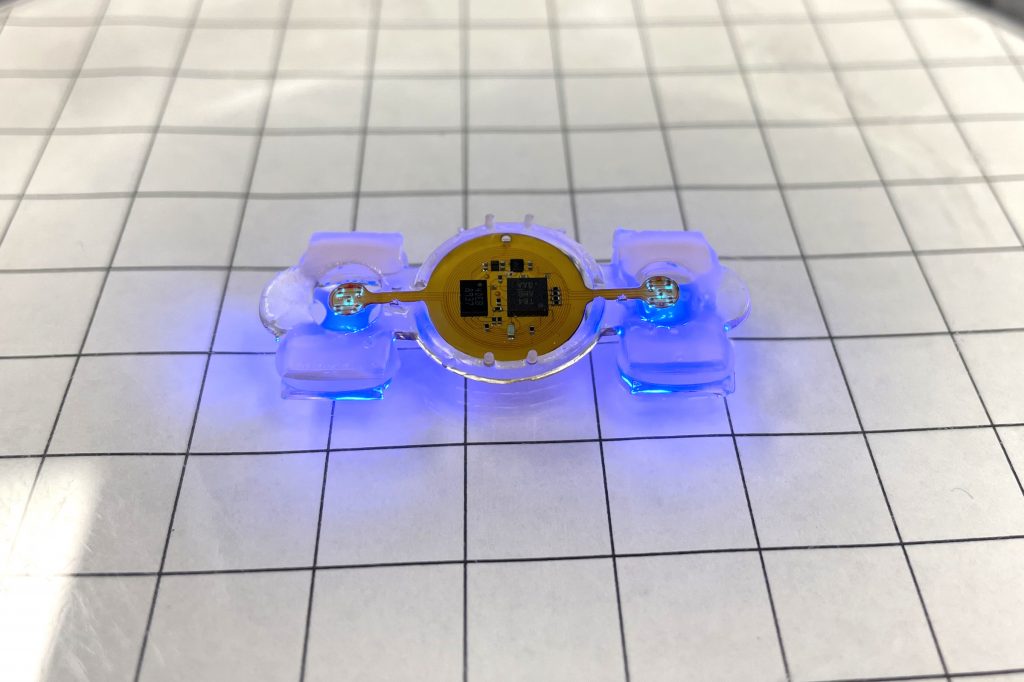
A photograph of an eBiobot prototype, lit with blue microLEDs. Remotely controlled miniature biological robots have many potential applications in medicine, sensing and environmental monitoring. Image courtesy of Yongdeok Kim
By Liz Ahlberg Touchstone
First, they walked. Then, they saw the light. Now, miniature biological robots have gained a new trick: remote control.
The hybrid “eBiobots” are the first to combine soft materials, living muscle and microelectronics, said researchers at the University of Illinois Urbana-Champaign, Northwestern University and collaborating institutions. They described their centimeter-scale biological machines in the journal Science Robotics.
“Integrating microelectronics allows the merger of the biological world and the electronics world, both with many advantages of their own, to now produce these electronic biobots and machines that could be useful for many medical, sensing and environmental applications in the future,” said study co-leader Rashid Bashir, an Illinois professor of bioengineering and dean of the Grainger College of Engineering.

Rashid Bashir. Photo by L. Brian Stauffer
Bashir’s group has pioneered the development of biobots, small biological robots powered by mouse muscle tissue grown on a soft 3D-printed polymer skeleton. They demonstrated walking biobots in 2012 and light-activated biobots in 2016. The light activation gave the researchers some control, but practical applications were limited by the question of how to deliver the light pulses to the biobots outside of a lab setting.
The answer to that question came from Northwestern University professor John A. Rogers, a pioneer in flexible bioelectronics, whose team helped integrate tiny wireless microelectronics and battery-free micro-LEDs. This allowed the researchers to remotely control the eBiobots.
“This unusual combination of technology and biology opens up vast opportunities in creating self-healing, learning, evolving, communicating and self-organizing engineered systems. We feel that it’s a very fertile ground for future research with specific potential applications in biomedicine and environmental monitoring,” said Rogers, a professor of materials science and engineering, biomedical engineering and neurological surgery at Northwestern University and director of the Querrey Simpson Institute for Bioelectronics.
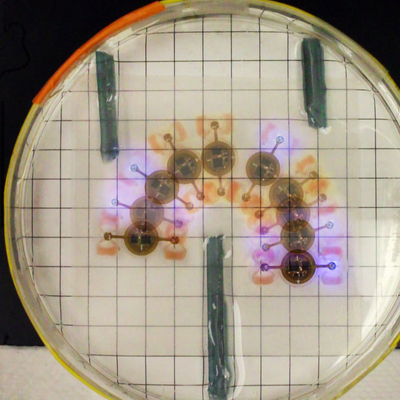
Remote control steering allows the eBiobots to maneuver around obstacles, as shown in this composite image of a bipedal robot traversing a maze. Image courtesy of Yongdeok Kim
To give the biobots the freedom of movement required for practical applications, the researchers set out to eliminate bulky batteries and tethering wires. The eBiobots use a receiver coil to harvest power and provide a regulated output voltage to power the micro-LEDs, said co-first author Zhengwei Li, an assistant professor of biomedical engineering at the University of Houston.
The researchers can send a wireless signal to the eBiobots that prompts the LEDs to pulse. The LEDs stimulate the light-sensitive engineered muscle to contract, moving the polymer legs so that the machines “walk.” The micro-LEDs are so targeted that they can activate specific portions of muscle, making the eBiobot turn in a desired direction. See a video on YouTube.
The researchers used computational modeling to optimize the eBiobot design and component integration for robustness, speed and maneuverability. Illinois professor of mechanical sciences and engineering Mattia Gazzola led the simulation and design of the eBiobots. The iterative design and additive 3D printing of the scaffolds allowed for rapid cycles of experiments and performance improvement, said Gazzola and co-first author Xiaotian Zhang, a postdoctoral researcher in Gazzola’s lab.
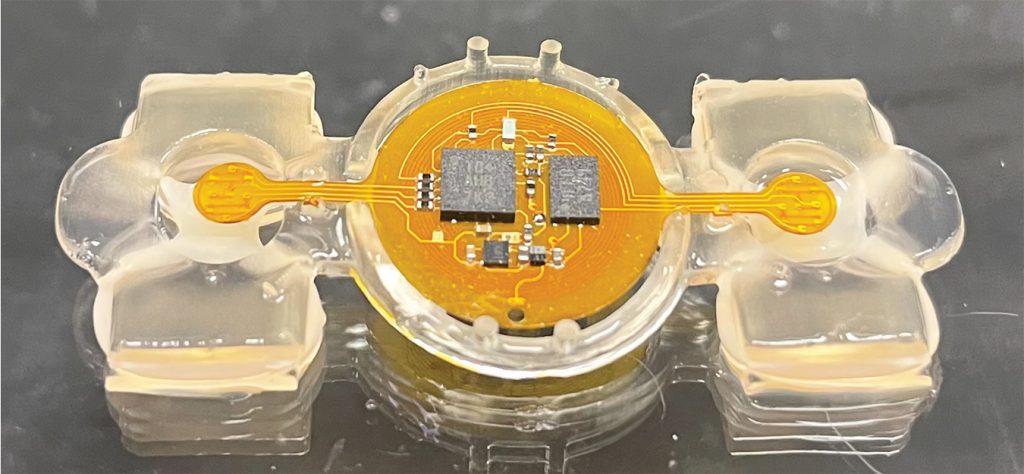
The eBiobots are the first wireless bio-hybrid machines, combining biological tissue, microelectronics and 3D-printed soft polymers. Image courtesy of Yongdeok Kim
The design allows for possible future integration of additional microelectronics, such as chemical and biological sensors, or 3D-printed scaffold parts for functions like pushing or transporting things that the biobots encounter, said co-first author Youngdeok Kim, who completed the work as a graduate student at Illinois.
The integration of electronic sensors or biological neurons would allow the eBiobots to sense and respond to toxins in the environment, biomarkers for disease and more possibilities, the researchers said.
“In developing a first-ever hybrid bioelectronic robot, we are opening the door for a new paradigm of applications for health care innovation, such as in-situ biopsies and analysis, minimum invasive surgery or even cancer detection within the human body,” Li said.
The National Science Foundation and the National Institutes of Health supported this work.
Piloting drones reliably with mobile communication technology
A lizard-inspired robot to explore the surface of Mars
Robot Talk Episode 35 – Interview with Emily S. Cross

Claire chatted to Professor Emily S. Cross from the University of Glasgow and Western Sydney University all about neuroscience, social learning, and human-robot interaction.
Emily S. Cross is a Professor of Social Robotics at the University of Glasgow, and a Professor of Human Neuroscience at the MARCS Institute at Western Sydney University. Using interactive learning tasks, brain scanning, and dance, acrobatics and robots, she and her Social Brain in Action Laboratory team explore how we learn by watching others throughout the lifespan, how action experts’ brains enable them to perform physical skills so exquisitely, and the social influences that shape human-robot interaction.
How robots can regain the trust of humans after making mistakes
Sea creatures inspire marine robots engineered to operate in extraterrestrial oceans
Vine-inspired robot can turn toward a heat source
Improving Materials Processing With Robotics
Improving Materials Processing With Robotics
Sea creatures inspire marine robots which can operate in extra-terrestrial oceans
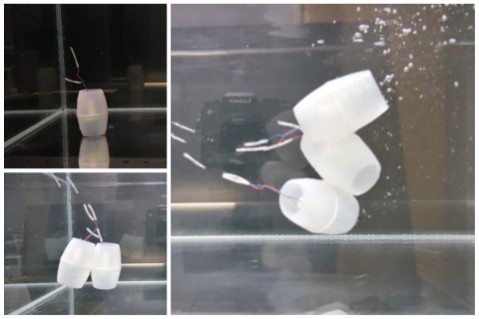
RoboSalps in action. Credits: Valentina Lo Gatto
These robotic units called RoboSalps, after their animal namesakes, have been engineered to operate in unknown and extreme environments such as extra-terrestrial oceans.
Although salps resemble jellyfish with their semi-transparent barrel-shaped bodies, they belong to the family of Tunicata and have a complex life cycle, changing between solitary and aggregate generations where they connect to form colonies.
RoboSalps have similarly light, tubular bodies and can link to each other to form ‘colonies’ which gives them new capabilities that can only be achieved because they work together.
Researcher Valentina Lo Gatto of Bristol’s Department of Aerospace Engineering is leading the study. She is also a student at the EPSRC Centre of Doctoral Training in Future Autonomous and Robotic Systems (FARSCOPE CDT).
She said: “RoboSalp is the first modular salp-inspired robot. Each module is made of a very light-weight soft tubular structure and a drone propeller which enables them to swim. These simple modules can be combined into ‘colonies’ that are much more robust and have the potential to carry out complex tasks. Because of their low weight and their robustness, they are ideal for extra-terrestrial underwater exploration missions, for example, in the subsurface ocean on the Jupiter moon Europa.”
RoboSalps are unique as each individual module can swim on its own. This is possible because of a small motor with rotor blades – typically used for drones – inserted into the soft tubular structure.
When swimming on their own, RoboSalps modules are difficult to control, but after joining them together to form colonies, they become more stable and show sophisticated movements.
In addition, by having multiple units joined together, scientists automatically obtain a redundant system, which makes it more robust against failure. If one module breaks, the whole colony can still move.
A colony of soft robots is a relatively novel concept with a wide range of interesting applications. RoboSalps are soft, potentially quite energy efficient, and robust due to inherent redundancy. This makes them ideal for autonomous missions where a direct and immediate human control might not be feasible.
Dr Helmut Hauser of Bristol’s Department of Engineering Maths, explained: “These include the exploration of remote submarine environments, sewage tunnels, and industrial cooling systems. Due to the low weight and softness of the RoboSalp modules, they are also ideal for extra-terrestrial missions. They can easily be stored in a reduced volume, ideal for reducing global space mission payloads.”
A compliant body also provides safer interaction with potentially delicate ecosystems, both on earth and extra-terrestrial, reducing the risk of environmental damage. The possibility to detach units or segments, and rearrange them, gives the system adaptability: once the target environment is reached, the colony could be deployed to start its exploration.
At a certain point, it could split into multiple segments, each exploring in a different direction, and afterwards reassemble in a new configuration to achieve a different objective such as manipulation or sample collection.
Prof Jonathan Rossiter added: “We are also developing control approaches that are able to exploit the compliance of the modules with the goal of achieving energy efficient movements close to those observed in biological salps.”
Sea creatures inspire marine robots which can operate in extra-terrestrial oceans

RoboSalps in action. Credits: Valentina Lo Gatto
These robotic units called RoboSalps, after their animal namesakes, have been engineered to operate in unknown and extreme environments such as extra-terrestrial oceans.
Although salps resemble jellyfish with their semi-transparent barrel-shaped bodies, they belong to the family of Tunicata and have a complex life cycle, changing between solitary and aggregate generations where they connect to form colonies.
RoboSalps have similarly light, tubular bodies and can link to each other to form ‘colonies’ which gives them new capabilities that can only be achieved because they work together.
Researcher Valentina Lo Gatto of Bristol’s Department of Aerospace Engineering is leading the study. She is also a student at the EPSRC Centre of Doctoral Training in Future Autonomous and Robotic Systems (FARSCOPE CDT).
She said: “RoboSalp is the first modular salp-inspired robot. Each module is made of a very light-weight soft tubular structure and a drone propeller which enables them to swim. These simple modules can be combined into ‘colonies’ that are much more robust and have the potential to carry out complex tasks. Because of their low weight and their robustness, they are ideal for extra-terrestrial underwater exploration missions, for example, in the subsurface ocean on the Jupiter moon Europa.”
RoboSalps are unique as each individual module can swim on its own. This is possible because of a small motor with rotor blades – typically used for drones – inserted into the soft tubular structure.
When swimming on their own, RoboSalps modules are difficult to control, but after joining them together to form colonies, they become more stable and show sophisticated movements.
In addition, by having multiple units joined together, scientists automatically obtain a redundant system, which makes it more robust against failure. If one module breaks, the whole colony can still move.
A colony of soft robots is a relatively novel concept with a wide range of interesting applications. RoboSalps are soft, potentially quite energy efficient, and robust due to inherent redundancy. This makes them ideal for autonomous missions where a direct and immediate human control might not be feasible.
Dr Helmut Hauser of Bristol’s Department of Engineering Maths, explained: “These include the exploration of remote submarine environments, sewage tunnels, and industrial cooling systems. Due to the low weight and softness of the RoboSalp modules, they are also ideal for extra-terrestrial missions. They can easily be stored in a reduced volume, ideal for reducing global space mission payloads.”
A compliant body also provides safer interaction with potentially delicate ecosystems, both on earth and extra-terrestrial, reducing the risk of environmental damage. The possibility to detach units or segments, and rearrange them, gives the system adaptability: once the target environment is reached, the colony could be deployed to start its exploration.
At a certain point, it could split into multiple segments, each exploring in a different direction, and afterwards reassemble in a new configuration to achieve a different objective such as manipulation or sample collection.
Prof Jonathan Rossiter added: “We are also developing control approaches that are able to exploit the compliance of the modules with the goal of achieving energy efficient movements close to those observed in biological salps.”
Our future could be full of undying, self-repairing robots. Here’s how
Humanoid robots to take centre stage at UN meet on AI
Our future could be full of undying, self-repairing robots – here’s how
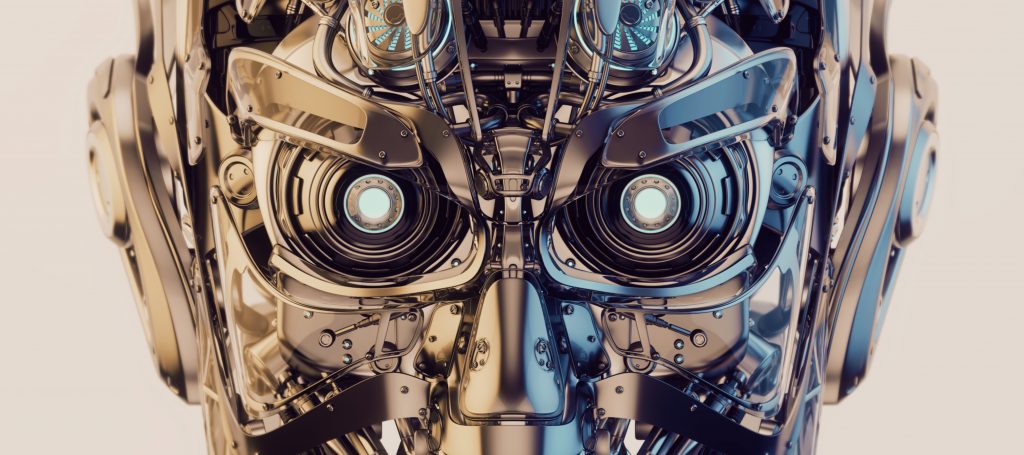
Robotic head, 3D illustration (frank60/Shutterstock)
By Jonathan Roberts (Professor in Robotics, Queensland University of Technology)
With generative artificial intelligence (AI) systems such as ChatGPT and StableDiffusion being the talk of the town right now, it might feel like we’ve taken a giant leap closer to a sci-fi reality where AIs are physical entities all around us.
Indeed, computer-based AI appears to be advancing at an unprecedented rate. But the rate of advancement in robotics – which we could think of as the potential physical embodiment of AI – is slow.
Could it be that future AI systems will need robotic “bodies” to interact with the world? If so, will nightmarish ideas like the self-repairing, shape-shifting T-1000 robot from the Terminator 2 movie come to fruition? And could a robot be created that could “live” forever?
Energy for ‘life’
Biological lifeforms like ourselves need energy to operate. We get ours via a combination of food, water, and oxygen. The majority of plants also need access to light to grow.
By the same token, an everlasting robot needs an ongoing energy supply. Currently, electrical power dominates energy supply in the world of robotics. Most robots are powered by the chemistry of batteries.
An alternative battery type has been proposed that uses nuclear waste and ultra-thin diamonds at its core. The inventors, a San Francisco startup called Nano Diamond Battery, claim a possible battery life of tens of thousands of years. Very small robots would be an ideal user of such batteries.
But a more likely long-term solution for powering robots may involve different chemistry – and even biology. In 2021, scientists from the Berkeley Lab and UMAss Amherst in the US demonstrated tiny nanobots could get their energy from chemicals in the liquid they swim in.
The researchers are now working out how to scale up this idea to larger robots that can work on solid surfaces.
Repairing and copying oneself
Of course, an undying robot might still need occasional repairs.
Ideally, a robot would repair itself if possible. In 2019, a Japanese research group demonstrated a research robot called PR2 tightening its own screw using a screwdriver. This is like self-surgery! However, such a technique would only work if non-critical components needed repair.
Other research groups are exploring how soft robots can self-heal when damaged. A group in Belgium showed how a robot they developed recovered after being stabbed six times in one of its legs. It stopped for a few minutes until its skin healed itself, and then walked off.
Another unusual concept for repair is to use other things a robot might find in the environment to replace its broken part.
Last year, scientists reported how dead spiders can be used as robot grippers. This form of robotics is known as “necrobotics”. The idea is to use dead animals as ready-made mechanical devices and attach them to robots to become part of the robot.
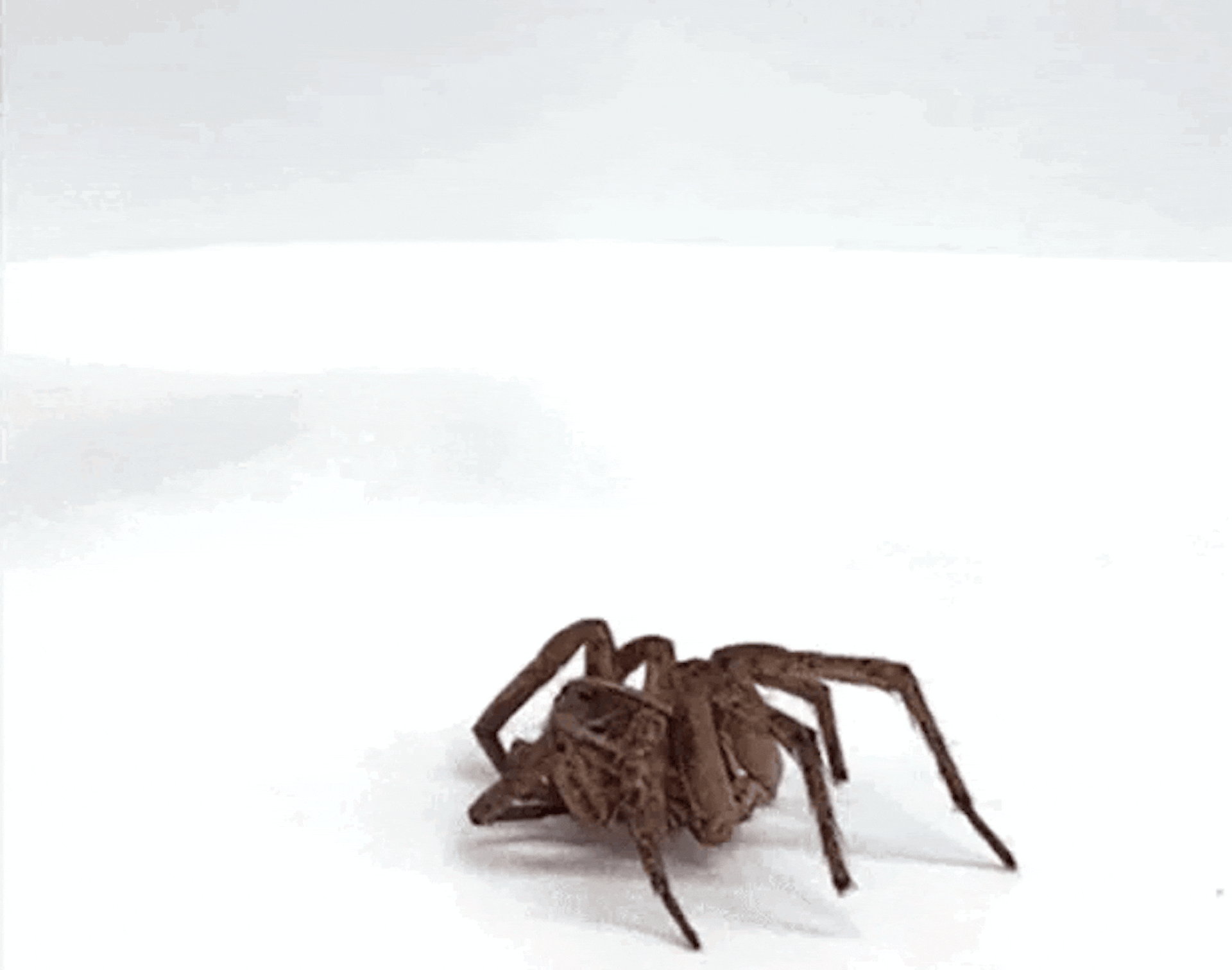
The proof-of-concept in necrobotics involved taking a dead spider and ‘reanimating’ its hydraulic legs with air, creating a surprisingly strong gripper. Preston Innovation Laboratory/Rice University
A robot colony?
From all these recent developments, it’s quite clear that in principle, a single robot may be able to live forever. But there is a very long way to go.
Most of the proposed solutions to the energy, repair and replication problems have only been demonstrated in the lab, in very controlled conditions and generally at tiny scales.
The ultimate solution may be one of large colonies or swarms of tiny robots who share a common brain, or mind. After all, this is exactly how many species of insects have evolved.
The concept of the “mind” of an ant colony has been pondered for decades. Research published in 2019 showed ant colonies themselves have a form of memory that is not contained within any of the ants.
This idea aligns very well with one day having massive clusters of robots that could use this trick to replace individual robots when needed, but keep the cluster “alive” indefinitely.

Ant colonies can contain ‘memories’ that are distributed between many individual insects. frank60/Shutterstock
Ultimately, the scary robot scenarios outlined in countless science fiction books and movies are unlikely to suddenly develop without anyone noticing.
Engineering ultra-reliable hardware is extremely difficult, especially with complex systems. There are currently no engineered products that can last forever, or even for hundreds of years. If we do ever invent an undying robot, we’ll also have the chance to build in some safeguards.![]()
Jonathan Roberts is Director of the Australian Cobotics Centre, the Technical Director of the Advanced Robotics for Manufacturing (ARM) Hub, and is a Chief Investigator at the QUT Centre for Robotics. He receives funding from the Australian Research Council. He was the co-founder of the UAV Challenge – an international drone competition.
This article is republished from The Conversation under a Creative Commons license. Read the original article.